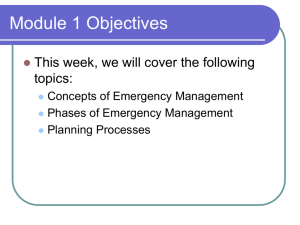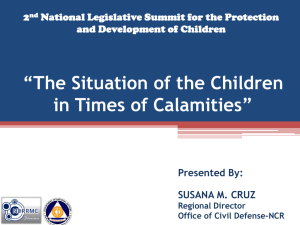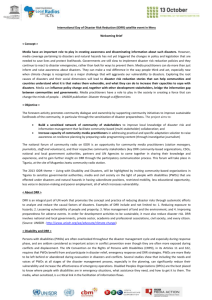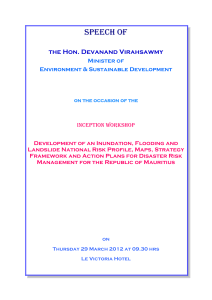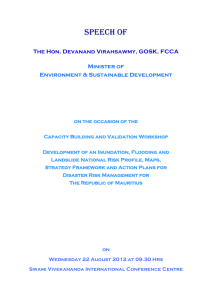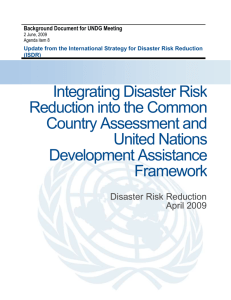Appendix8HydrometeorologicalhazardsLalljee
advertisement
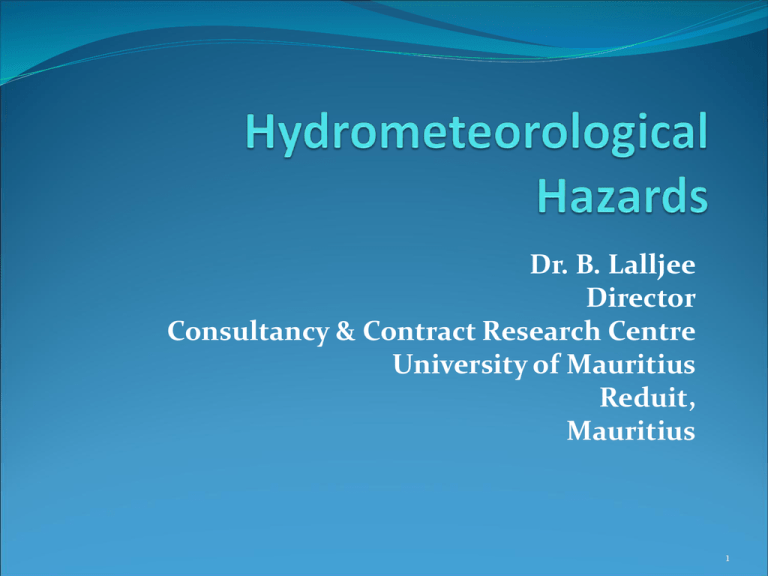
Dr. B. Lalljee Director Consultancy & Contract Research Centre University of Mauritius Reduit, Mauritius 1 Weather, water and climate-related hazards Sea level rise Hot & cold spells Tropical cyclones Storm surges Ice Storms Droughts Floods Heavy precipitations (rain or snow) Storm (winds) Dust storms Wildland fires & haze Hail&Lightning Mud & landslides Flash floods Avalanches Tornadoes 2 Casualties during 2000-2009 were 78,000 per year, although there were over 200,000 casualties in 2010 alone. Although number of people affected by natural events is increasing, the number of fatalities/deaths due to all natural disasters is decreasing. Could be due to better early warning and preparedness programmes. 3 Exacerbating Factors in Africa Lack of adequate human and institutional capacities for weather and climate modeling and forecasting. Weak/ non-existence of national Disaster Risk Reduction (DRR) and Disaster Management Systems. Lack of community based weather and climate Early Warning Systems (EWS). Poor institutional coordination. Lack of policy and legal framework on Disaster Management to facilitate the co-ordination and implementation of disaster preparedness activities. Poverty and low level of disaster resilience in many communities (making vulnerability very high). 4 Climate Change A key driver of increasing hydrometeorological disasters, especially global warming and sea level rise. A challenge to humankind. Flooding is a global concern & increasing in its intensity. It is forecasted that temperature increase of 3-4oC could result in displacement of nearly 330 million people only through flooding. A 1 metre sea level rise would make at least 56 million people environmental refugees in the developing world. 5 Some Climate Change Impacts (IPCC) In 2100 : half of the world’s population will sufffer from water stress Subtropical zones: Less precipitation and increased desertification Tropical zones: Increased health risks High latitudes: permafrost decrease Coastal zones: coastal erosion; storm surges; salt water intrusions Cost of global warming in 2050: 300 billion USD per year 6 Natural Disasters in the World 7 Water-related disasters 8 Trend in Annual Rainfall Over Mauritius ANNUAL RAINFALL 4000 3500 3000 MILLIMETRE 2500 2000 1500 1000 500 0 1904 1908 1912 1916 1920 1924 1928 1932 1936 1940 1944 1948 1952 1956 1960 1964 1968 1972 1976 1980 1984 1988 1992 1996 2000 2004 YEAR 9 Extreme weather amplified by global warming will lead to frequent disasters that will exceed societal capacity to mitigate and to adapt River flow Floods Societal capacity Droughts Present time 10 Trend in Tropical Cyclone Intensity during the last 30 years 50 Moderate 45 Severe T.Cyclone Linear (T.Cyclone) No. of formations 40 35 30 25 20 15 10 5 0 1975-85 1985-95 1995-2005 Decades 11 Global Temperature 12 Sea level in Rodrigues (Mauritius) 13 Vulnerability Factors to Flooding ≈ Poor/ inadequate and constricted drainage systems. ≈ Blockage of drains by solid wastes in urban areas. ≈ Uncontrolled logging, deforestation, soil erosion & silting of river beds. ≈ Removal of sand, gravel and boulders from river beds for supporting construction industry. ≈ Small river catchment area. ≈ Steep terrain conditions. ≈ Low lying coastal areas. 14 Key functional components of Early Warning Systems for hydrometeorological hazards - Risk Assessment, including hazard assessment and vulnerability analysis - Hazard Detection - Hazard Prediction - Communications and Dissemination - Public Awareness - Coordination - Post-Disaster Support 15 Disaster management cycle Disaster Preparedness Mitigation Response Recovery 16 Framework for guidance and monitoring of disaster reduction Risk identification Knowledge management Risk management applications Preparedness and emergency management Governance support 17 Risk identification Monitoring Early warning for weather-, water- or climate- related disasters Adaptation measures Vulnerability assessment and Hazard analysis 18 Knowledge Management Need further improvements in the prediction of highimpact weather and in the full utilization of forecast information Need user education and awareness : to increase weather literacy and interest in meteorological topics to ensure that warnings and forecasts provided by the authorities are understood by the intended users to build up a high level of awareness of hazards and preparedness to enable emergency management authorities to make well-informed decisions. 19 Risk management applications Examples include : The Associated Programme on Flood Management promotes the concept of Integrated Flood Management across sectors. WMO’s Agricultural Meteorology Programme provides guidance on the development of support systems for sustainable land management and agroclimatic zoning. 20 Preparedness and emergency management Timely and accurate forecasts and warnings of natural hazards coupled with adequate local preparedness planning are fundamental requirements for disaster reduction. Optimal response to natural disasters requires effective coordination and cooperation between responsible agencies, institutions, officials, the media, political leaders and other players at local, national and international levels. 21 Governance Support Legislation and adequate normative framework are essential to implement risk management. Political commitment is crucial to allocate the necessary resources. Contributions of National Meteorological and Hydrological Services need to be integrated in national disaster management plans. 22 International Framework Natural disasters affect all countries, but burden falls disproportionately on developing countries. Support to natural disaster reduction is both an issue of sustainable development and a matter of environmental justice requiring international solidarity. 23 Disaster Risk Reduction (DRR) Strategies for African Countries Africa is highly vulnerable to extreme hydro- meteorological events, and climate related disasters will continue to impact on African economies and societies. Understanding climate risks and their causes is important in dealing with climate extreme events and disasters. Downscaling climate information to local levels is critical in dealing with DRR. Development of an effective EWS will improve DRR. Urgent need for the development and strengthening of flood and drought EWS. 24 Disaster Risk Reduction (DRR) Strategies for African Countries contd Sensitise Governments to develop appropriate policy frameworks. Enhance dissemination and communication for an informed decision making and support. Enhance public education and awareness including institutional capacity building. Develop knowledge and share it with relevant institutions. Strengthen Early Warning Systems for monitoring, detection, attribution and prediction of high impact weather, climate events and climate change. Prioritize hazards and their mappings. Conduct vulnerability analysis and mapping. Improve accuracy and use of climate and weather information. Adopt a bottoms-up, community-based approach to DRR through community sensitization, education and involvement at all stages : from risk mapping and assessment, disaster preparedness, response and recovery stages. Adopt a multi-hazard approach to DRR. 25 Project HD 02: Hydrometeorological Hazards and Disasters in subSaharan Africa: Vulnerability and Resilience Objectives The objective of this project is to assess the vulnerability of socio- ecological systems in sub-Saharan Africa to hydrometeorological hazards and disasters, and the resilience of communities to these events. The project also aims at strengthening the capacities of developing countries for disaster planning and management, and for promoting and facilitating transfer of early warning technologies to disaster-prone communities. 26 1. Drought events in sub-Saharan Africa Activities •Investigating the impacts of climate change and droughts in the Sahel, including the effect on agriculture, water resources, air quality, cattle production, ecosystems, and health •Set up a long-term warning and monitoring system for climate change, drought and desertification •Develop human and institutional capacity building initiatives at the country and regional levels 27 Sub projects 3. Climate change and socio-economic determinants for anthropogenic fires in African savannahs 4. Dust events and related hazards in sub-Saharan Africa Activities 5. Physical and socio-economic approaches for supporting adaptive water management in sub-Saharan Africa (incomplete) 28 Next Steps 3 years have elapsed since the formulation of these projects Change in paradignms and priorities in certain sectors Rio +20 conference in Brazil has laid emphasis on Green economy and Sustainable Development framework. Need to revisit the subprojects in terms of objectives and outcomes Need to reformulate the budget Need to complete the subproject on Water 29 Conclusion Climate change, the largest environmental change in this century is likely to intensify hydro-meteorological hazards and lead to large-scale population movements/ ecomigration. Climate change is a human–induced phenomenon. Much of the issues are intricately linked to social and human dimensions and the solution to these problems therefore lies in the social and human dynamics/ action. No single set of approach can provide solution to the ill effects of climate change. A mix of technical, behavioral and policy approaches is needed in minimising the effects of natural hazards. 30 Conclusion contd. An Integrated Approach is Needed at : National and regional levels Role of National Meteorological and Hydrological Services Cooperation across disciplines and agencies Links with academic community. International level Between IGOs and NGOs concerned Capacity building and transfer of technology activities. 31 Dry reservoir 32 Drought 33 Flood 34 Sunamis 35 Sunamis 36 37 l 38 39 Floods in Mauritius 40 Thank you for your attention ! 41



